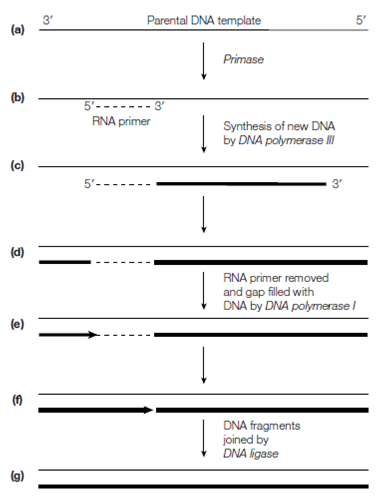RNA primer:
DNA polymerase cannot begin DNA synthesis without a primer. Either on the lagging stand, every Okazaki fragment needs an RNA primer previous to DNA synthesis can begin. The primer used in every case is a short piece of RNA and is synthesized through an RNA polymerase known as primase Primase can make RNA straight on the single-stranded DNA sample since, such as all RNA poly- merases, it does not need a primer to start synthesis. The RNA primer made through primase is then extended through DNA polymerase III. DNA polymerase III synthesizes DNA for both the lagging and leading strand. Following DNA synthesis through DNA polymerase III, DNA polymerase I uses its 5' → 3' exonuclease activity to erase the RNA primer and then fills the gap with new DNA. The DNA polymerase III cannot hold out this task since it lacks the 5' → 3' activity of DNA polymerase I. At last, DNA ligase joins the ends of the DNA fragments together.

figure: Details of DNA replication. (a) Primase binds to the DNA template strand (thin line) and (b) synthesizes a short RNA primer (dotted line); (c) DNA polymerase III now extends the RNA primer by synthesizing new DNA (thick line); (d) during synthesis of the lagging strand, adjacent Okazaki fragments are separated by the RNA primers; (e) the RNA primers are now removed and the gaps filled with DNA by DNA polymerase I (f) generating adjacent DNA fragments that are then (g) joined by DNA ligase.